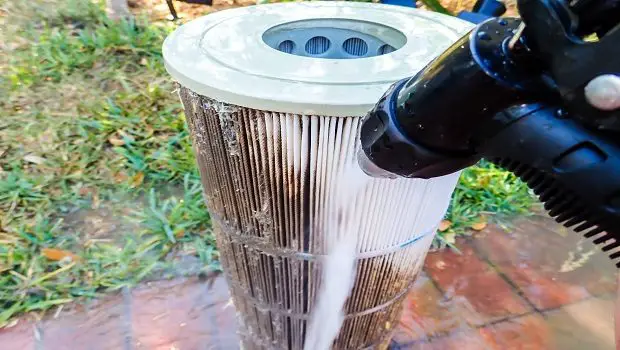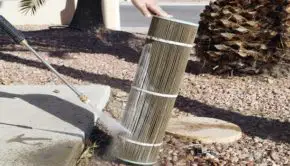How to Clean Every Type of Pool Filter
DISCLOSURE: As an Amazon Associate, I earn from qualifying purchases.
Has your swimming pool water become murky or cloudy?
Are you concerned it will be, soon?
Then its high time you clean your pool filter!
However complicated the task may look at first, with attention and care your swimming pool filter will serve for years.
And cleaning a pool filter properly takes just a few minutes if you know what you’re doing.
This article explains how to do it right.
Three of a Kind
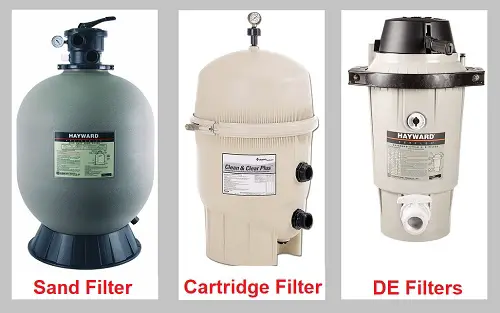
There are three kinds of pool filters commonly in use, and it is essential to understand which type your swimming pool is using. Cleaning is markedly different for each.
The three types of filters include:
Sand Filters
- Most affordable.
- Your pump forces pool water through a tank around half-full of silica sand, which grabs the debris and other particles before passing clean water back into your pool.
- Sand filters are long-lasting and easy to maintain.
- •The primary disadvantage of sand filters is they aren’t effective at trapping the smallest particles without the aid of a secondary filter.
Cartridge Filters
- Cartridge filters are mid-priced pool filters.
- Efficient and easy to maintain, but require removal from the unit.
- Cartridge filters have a tubular fan-folded polyester cartridge as the filtering tool. Water runs through the fabric and traps debris.
- Cartridge filters are referred to as “green” filters because they can not be back-washed, and because of this use less water when being washed.
- These filters can trap smaller particles.
Diatomaceous Earth (D.E.) Filters
- Although the priciest, D.E. Filters are also the best because they can screen all but the tiniest bits of debris.
- D.E. filters clean your water by moving it through a fine powder made from the fossils of diatoms, an aquatic plant.
- D.E. filters can be back-washed to clean them in place, meaning less work for you.
Sand Filter Cleaning Process
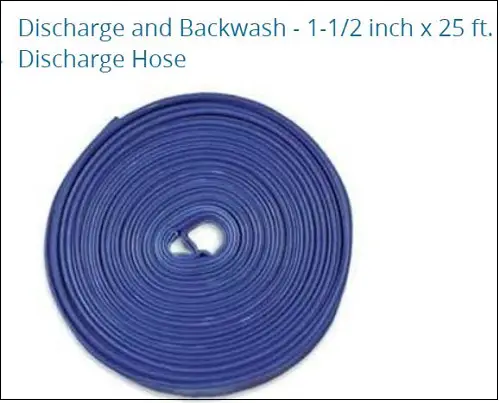
Tools/Supplies needed
- Back-wash hose
- Sand filter cleaner
- Owner’s manual
Procedure: Cleaning a Sand Pool Filter
The process for sand pool filter cleaning is simple. It can be back-washed, which you should do when it reaches 8-10 PSI over the standard operating level. Or you will want to get it done when the pool water becomes cloudy.
At least twice a year, your sand filter should clean — using a cleaner that works – while back-washing the filter. Here is how:
- Start back-washing the filter to remove debris and dirt.
- Gradually add the sand filter cleaner into the skimmer.
- Back-wash the filter for 3 to 5 minutes to remove debris and dirt, which have been dislodged by the filter cleaner.
- When complete, switch the filter pump off. Move the back-wash valve handle to the “filter” position and turn the filter pump back on.
- If you experience issues after cleaning your filter or back-washing does not lower the psi, it could be time to replace the sand.
See? Quick and simple! Using sand filters, you can spend less time cleaning and more time having fun into your pool.
Cleaning a Cartridge Filter
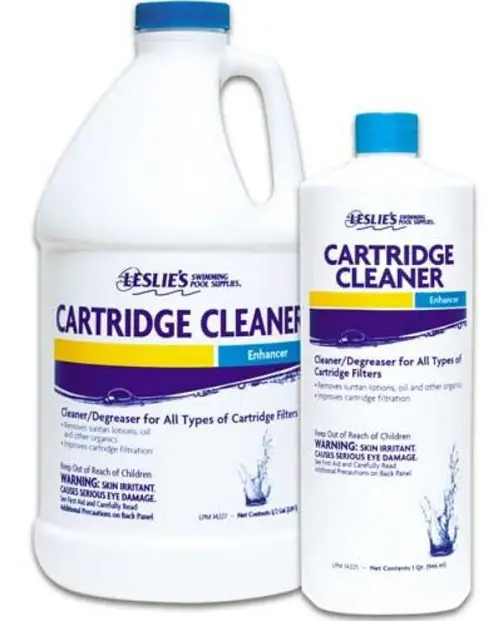
Tools/Supplies needed
- Garden hose
- Spray nozzle
- Wrench set (or equal )
- Filter cleaner
- Large bucket (if desired )
- Non-petroleum-based lubricant
- Replacement O-ring (if necessary )
- Replacement filter cartridges (if desired )
- Rubber mallet (for multi-element filters)
- Owner’s manual (just in case)
Procedure: Cleaning a Cartridge Pool Filter
A cartridge filter is also simple to clean; you just pull out the cartridges, clean them, and replace them. But there are several steps to follow to make sure it’s done.
- Turn your pool pump off.
- Eliminate air from the system by gradually opening the air-relief valve (generally located on top of the filter) to eliminate any excess air from the system.
- Remove the assembly or clamp holding the filter together. Your owners manual might come in handy here.
- Remove the top of the filter.
- Slowly and carefully eliminate the cartridges and put them aside. Inspect everything for wear and damage. If you find any tears or cracks or a cartridge is mushy, it’s time to replace it.
- Clean the cartridge with a spray nozzle on your backyard pipe – spray at an angle to get between the pleats. Do not use a pressure washer; it will break the cartridges.
- If the cartridge is truly dirty, use a filter cleaner. Follow the directions of the manufacturer.
- If the cartridge is really, very dirty, soak it in filter cleaner immediately. Use a five-gallon bucket or plastic trash can, and be sure that the cartridges are submerged in the cleaner and water mixture.
- Return the cartridges and fasten them.
- Replace the filter top and tighten the assembly or the clamp.
- Next, see the O-ring on the filter tank. If it’s in great shape, lightly apply some grease to make it that way. If it’s deformed, dry-rotted, stretched or seems worn out, replace it. It’s always a great idea to change the tank O-ring at each cleaning.
- Turn the machine back on and open the air relief valve to release any air. Keep the lid open from it until a flow of water sprays, then shut.
- Check the system pressure to make sure it is in the normal range. If the pounds per square inch (PSI) is off, you might have put the filter back together wrongly, or something else may be bad with the machine. Troubleshoot the pool filter to identify and fix the problem.
Manually Cleaning a D.E. Filter
Tools/Supplies needed
- Lubricant
- Back-wash hose
- Garden hose
- Dust mask
- Diatom acerous ground (D.E.) filter cleaner
- 5-gallon bucket
- Large, plastic spoon for mixing D.E.
- D.E. powder
- Acid-resistant gloves
- D.E. Filter Cleaner
- Safety goggles
- Owner’s manual
Procedure: Cleaning a DE Pool Filter
Diatom earth filters have to be manually cleaned at least two times a year. The quickest, easiest way is to use the D.E. filter cleaner. Here’s how to begin:
- Back-wash the filter for 3 to 5 minutes to remove the old D.E., debris, and dirt.
- Turn off the pump and set the back-wash valve back into the “filter” mode.
- Open the air relief valve.
- Detach the drain plug and let the water drain out of the filter tank.
- Remove the assembly or clamp holding the filter together. See the owner’s manual if you don’t know how to start it.
- Open the filter tank by eliminating the top half.
- Rinse the container with the garden hose and then attach the drain plug.
- Clean the manifold and grids:
- Use a spray nozzle on your garden tube to spray down the manifold, ensure to thoroughly flush the grids of all dirt, and used D.E.
- If the grids are really dirty, take a D.E. filter cleaner. Follow the instructions of the manufacturer and use safety gear.
- Inspect the grids for damage or rips, and check the manifold for cracks.
- Put the clean grids back into the filter tank, line up and set up the manifold, and secure the nuts. Do not overtighten. If there is a standpipe O-ring, change it.
- Grease the filter tank O-ring within the container and place the top half of the filter tank.
- Add DE powder to the filter:
- Consult with a filter owner’s manual to determine how much D.E. powder you will need to add.
- In a bucket, mix the appropriate quantity of D.E. Powder with enough water to make a slurry, a thin, creamy solution with the consistency of milk. Use the big spoon to mix.
- Prime the filter pump by lifting the strainer housing lid and filling the water in strainer housing; let some water to circulate through the incoming line. Grease the pump lid O-ring, if required, and close the lid.
- Open the filter air-relief lid to release extra air from the filter tank.
- Turn the pump on and let it run to make sure you have full circulation.
- When water starts coming out, close the air relief valve. While the pump is running, gradually pour the slurry to the pool skimmer.
- Run the pool pump for a minimum of 30 minutes to allow the D.E. to spread uniformly over the filter grids. Check for any D.E. returning into the pool in the return line; if you find any, you might have a ripped grid, cracked manifold, or torn stem O-ring.
And there you have it! Follow the measures for your particular filter type to maintain your filter and your pool clear and clean.
Be sure to keep all essential supplies on hand so you’re always ready to clean your sand, diatomaceous earth, or cartridge filter properly.

